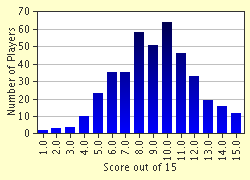Quiz Answer Key and Fun Facts
1. Clouds come in assorted types. One classification is cloud base height: low, middle-level, high. Which of these is a middle-level cloud?
2. Another classification is stratification - whether a cloud is flat, or convective uplift makes it "bumpy". Which of these is cumuliform?
3. Many clouds are difficult to categorise. A common cloud formation has equal characteristics of cumuliform and stratiform. Which is it?
4. Clouds can also be classified by the causation of their formation. This can be by orographic uplift, by frontal uplift, or by convection, and of course by a combination of causes. Which cloud is formed solely by orography (terrain)?
5. Why do most low-level clouds have flat bases?
6. In a stable airmass (little convection) with strong winds, it is possible to see which interesting cloud?
7. Dark clouds are caused by the evaporation of dirty water.
8. You can get very wet when the main cloud is nimbostratus.
9. High atmospheric pressure is usually associated with dry weather.
10. The World Meteorological Organization defines standard code listings for all clouds. For example, cumulus is Cu and altocumulus is Ac. What is the code for cumulonimbus?
11. To generalise, the wettest regions of the world are the tropics, the driest, the poles. What is NOT a reason for this?
12. The driest regions always have little cloudiness.
13. The largest cloud masses are those associated with low-pressure regions. Why is this?
14. What is a cold front?
15. What cloud is associated with tornado formation?
Source: Author
brian59
This quiz was reviewed by FunTrivia editor
crisw before going online.
Any errors found in FunTrivia content are routinely corrected through our feedback system.


